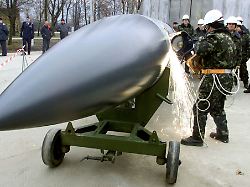“Not intercepted yet”
Russian special missile causes problems for Ukraine
December 30, 2023, 9:54 a.m
Listen to article
This audio version was artificially generated. More info | Send feedback
In Russia’s largest air raid since the start of the war, 30 people die on the Ukrainian side. Although Ukraine can intercept dozens of drones and missiles, a special type of missile is causing problems for Ukrainian air defense.
Since the start of the attack on Ukraine, Russian forces have fired around 300 Ch-22 missiles into the neighboring country. None of them have been intercepted or shot down so far, Air Force spokesman Yuri Ihnat said on Ukrainian television.
A modified version of the missile was likely among those that overcame Ukrainian air defenses on Friday. A total of 30 people were killed on Friday in Russia’s largest air strike since the start of the war. According to its own information, the Air Force shot down 87 cruise missiles and 27 drones from the air out of a total of 158 “targets” fired by Russia.
“The Ch-22 missile flies at a speed of four thousand kilometers per hour, it usually reaches its target on a ballistic trajectory, so special means are required to intercept it,” Ihnat said. You need air defense like the Patriot system. The modernized version of the rocket, the Ch-32, was also deployed by Russia on Friday. So far, the Russian armed forces have mainly used cruise missiles of this type in the east and south.
The Ch-22 “Burja” (translated as “Storm”) is a Soviet-era, long-range supersonic cruise missile. Armed with a nuclear or high-explosive warhead, it was originally designed to destroy aircraft carriers and other large warships.
Rockets as partial payment for gas debts
In total, around 3,000 of the five-ton rockets were manufactured in the USSR. After the collapse of the Soviet Union, some of them remained in Ukraine. However, shortly after gaining independence in 1991, Ukraine gave up its nuclear and strategic arsenal. In 2000, Ukraine handed over 386 Ch-22 missiles to Russia as partial payment of its gas debt.
The latest modification of the Ch-22 does not use radar to find and capture a target, but has an autopilot that directs it to specific coordinates at a specific altitude depending on the surface geometry. Its high speed poses a problem for air defense systems. The less time the missile is in the air, the more difficult it is to shoot it down. The Kalibr cruise missiles that Russia launches from the Black Sea are three times slower than the Ch-22 – making it easier to lock on to the missiles.
